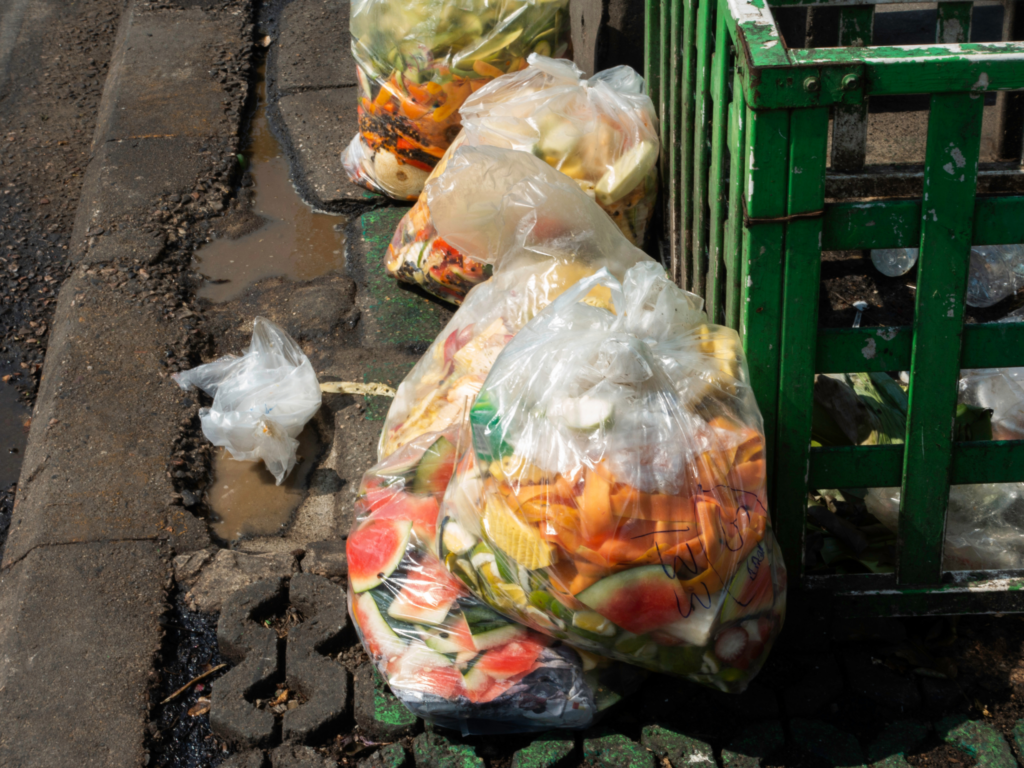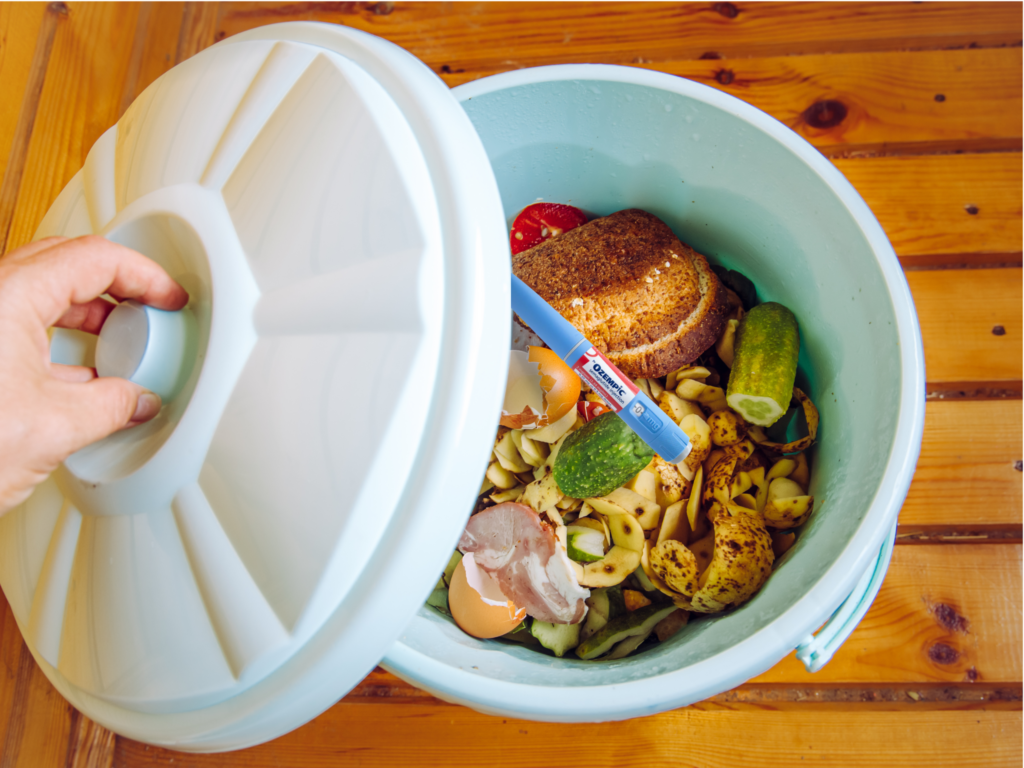ReFED’s Sara Burnett: ‘GLP-1 Drugs & AI Will Have Profound Impacts on US Food Waste’
8 Mins Read
Sara Burnett, executive director of non-profit ReFED, talks food waste in the US, state bans, and the “profound impact” of AI and Ozempic.
Food waste in the US has reached a four-year high, reaching 73.9 million tonnes – or 31% of the country’s food supply – in 2023, according to a new report by non-profit organisation ReFED.
Shockingly, only 2% of this surplus food is donated; a higher share goes to livestock feed (9%), and 85% ends up at waste destinations. This amounts to economic losses worth $382B (1.4% of the national GDP), accounts for 4% of its greenhouse gas emissions, and results in 120 billion lost meals, which is enough to feed a third of the population for a year.
ReFED’s 2025 US Food Waste Report found that the biggest contributors to surplus food are households (35% of the total), driven in part by consumer confusion over labelling – 43% of Americans throw away food just because it’s close to or past the package date (up from 37% in 2016).
The Biden administration launched the country’s first national food waste policy last year, while 12 states have already restricted or banned organic waste. Federal funding to fight food waste and loss surpassed $300M in 2024, although it’s much lower than the $640 invested privately.
These efforts from policymakers, combined with business initiatives like the Food Waste Pact, are showing promise in abating the crisis, but several factors will influence food waste reduction in 2025 – including artificial intelligence (AI), inflation, GLP-1 drugs like Ozempic, and COP30.
To dive deep into the topic, we spoke to Sara Burnett, executive director of ReFED, who outlined why food waste is on the rise, why only a small share gets donated, how policymakers are helping, and why 2025 could be a big year for food waste.
This interview has been edited for clarity and concision.
Green Queen: Why has food waste increased since the pandemic?

Sara Burnett: During the pandemic, rates of uneaten and unsold food – what we call surplus food – decreased as more people cooked their meals at home, ate more of the food they purchased to limit trips to the grocery store, and avoided eating out at restaurants (which can lead to waste when you neglect those leftovers in your fridge).
Since then, rates of surplus food have bounced back to where they were pre-pandemic. So I wouldn’t say that waste has necessarily increased since the pandemic, but more normalised to where we were in the years leading up to Covid-19.
GQ: How does food waste cause GHG emissions, and at such high levels?
SB: ReFED’s analysis indicates that surplus food is responsible for 4% of US greenhouse gas emissions, the same as driving 54 million cars, or 18% of all registered vehicles in the country.
The entire life-cycle of uneaten food creates emissions, from its production, to transport, to storage, preparation, and ultimate disposal. Production and supply chain emissions, which are emitted as food moves from farm to fork, outweigh emissions from disposal 92% to 8%.
When food ends up in a landfill, a greenhouse gas called methane is produced – and this has a warming potential 80 times more powerful than carbon dioxide when we measure over a 20-year period. Analysis ReFED conducted last year found that keeping food out of landfills could avoid methane emissions equivalent to taking 16 million cars off the road.
Preventing food from going unsold or uneaten is by far the most impactful climate solution – for example, although composting is a great way to recover the carbon and nutrients in food, all of the resources and emissions required to produce it and get it to your plate are still being wasted.
GQ: Households still make up the largest chunk of food waste. How can that be effectively addressed?

SB: Between uneaten groceries and restaurant plate waste, consumers waste nearly 35 million tons of food annually, costing them nearly $800 per person. Raising consumers’ awareness about how much food they waste and how to manage it more effectively could significantly reduce household food waste. Another cause of food waste in homes is confusion over date labels – ReFED estimates that nearly 1.5 million tons of food gets discarded because of concerns about date labels.
Standardising date labels (coupled with education about their meanings) is one of the most cost-effective ways to reduce food waste in homes. Fortunately, there is action happening at the state and federal level, as well as within industry, to reform date labels to reduce confusion. One example comes from California, which recently passed legislation to standardise food date labels starting in 2026.
GQ: What measures have had a tangible impact on businesses’ waste footprint?
SB: In our latest report, we point out a few examples of food companies that are implementing technology to prevent food waste. Waste tracking and analytics software is one solution that a lot of foodservice businesses use to drive waste reductions.
In fact, last year, Guckenheimer announced a 64% reduction in food waste from a 2022 baseline and cites waste tracking as a key step to achieving that goal. Danone North America saw a 50% increase in the sell-through rate of its excess product after partnering with Spoiler Alert, a software platform focused on liquidation. In addition, more businesses are setting targets, measuring, and reporting waste through pre-competitive collaborations like the US Food Waste Pact.
The US Food Waste Pact continues to add key signatories, including Starbucks, Amazon Fresh, and Chick-fil-A, bringing the total signatory base today to 18 businesses across retail, manufacturing, foodservice, and quick-service restaurants.
GQ: Why is so little food donated? And how can that be changed?

SB: ReFED estimates that only 12% of the 14.5 million tons of food that could be donated actually gets donated. There are many reasons for this, from liability concerns (even though protections are in place) to lack of storage capacity for food donations to distribution and logistics challenges, particularly when it comes to donating fresh produce.
A stronger food rescue system requires expanded storage, transportation, and staffing capacity within food rescue organisations – as well as a consistent flow of goods from food business donations, which can be achieved by implementing solutions like business education or coordination and matching technologies that make food donation easier.
Fortunately, donations seem to be on the rise. Feeding America’s data from over 200 member food banks indicates that in both 2023 and 2024, the volume of food donated to the network from retailers alone increased by over 5% from the prior year.
We’re seeing businesses proactively improving their donation programs, recognising that they offer a “win-win-win” of cost savings and tax incentives, reduce food insecurity, and minimise environmental impacts by diverting food from landfills.
GQ: The US launched a national food waste reduction strategy under the Biden administration. Do you believe it went far enough? How will it be affected under Trump?
SB: The National Strategy for Reducing Food Loss and Waste and Recycling Organics identified concrete steps to accelerate the prevention of food loss and waste where possible and practical, and the recycling of the remainder of organic waste. It is pretty comprehensive and has guided some additional actions, such as a request for information on food date labelling from the USDA-FDA, and grant funding for a consumer-facing education campaign on reducing food waste.
It is our firm belief that advancing solutions to food waste is a non-partisan issue that receives support from both sides of the aisle. And the 2030 Food Loss and Waste Reduction Goal has been maintained throughout the past three administrations – so we’re hopeful that this new administration will continue to support action to reduce food waste including the national strategy.
GQ: How effective have state policies been? And how can they be improved?

SB: It depends on the policy – there are state-level policies around several things, including food donation liability protection, food date labels, and organic waste landfill bans.
State-level organic waste bans are one of, if not the most important, policies for states to consider for food waste reduction. In requiring food scraps to go somewhere other than landfills, waste bans help to avoid the methane that typically comes from food rotting in landfills. They also establish demand for the development of organics recycling infrastructure, which requires a lot of capital investment and does not always have a business model if waste bans aren’t in place.
In addition, waste bans can have a cascading effect on promoting the prevention of wasted food and the recovery of edible food. While recent progress made at the state level is promising – for example, Vermont reported a 13% reduction in the tons of food scraps sent to landfill between 2018 and 2023, attributed to the state’s organic waste ban – we do believe stronger policies that incentivise prevention and food donation are urgently needed as well.
GQ: How will GLP-1 drugs affect food waste going forward?
SB: The short answer is that we anticipate that GLP-1 medications and AI will have profound impacts on food waste in the future.
When it comes to GLP-1s, there are estimates that anywhere from 15 to 30 million people could be taking these medications by 2030. The open question now is: how will this impact the type and quantity of foods that consumers demand? These impacts could have ripple effects throughout the food supply chain, which could mean increased wasted food initially.
GQ: And what about AI?
I think, just like every other industry, the food system will be significantly impacted by artificial intelligence. A handful of food waste solutions are already utilising AI to analyse data and generate valuable insights to drive greater reductions in waste.
Machine learning, a subset of AI, has the capacity to process significantly more data than a human and can, for example, make predictions like how many apples would sell on a rainy day in October in Boston based on past trends.

GQ: Will food waste play a key role in countries’ nationally determined contributions (NDC) and COP30?
SB: Last November, we were excited to see more than 30 countries sign on to the COP29 Declaration on Reducing Methane from Organic Waste. Because of the significant greenhouse gas emissions associated with food waste – 8-10% globally – we think incorporating food waste reduction into NDCs is essential to achieving broad reductions.
We’re confident that COP30 will be a big year for food waste, and we’re excited to work with our partners across the country and the globe to make sure reducing wasted food is on the table.



